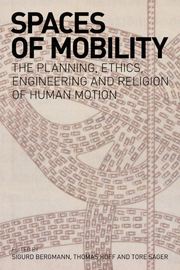Book contents
- Frontmatter
- Contents
- List of illustrations and tables
- Contributors
- Preface
- Acknowledgements
- 1 The beauty of speed or the cross of mobility? Introductory reflections on the aesth/ethics of space, justice and motion
- Part I
- 2 Hypermobility and the forecast-free planning of society
- 3 ‘Green’ attitudes and sustainable household consumption of energy and transport: six conditions that improve attitude–behaviour consistency
- 4 Travelling as pilgrimage: ecotheological contributions to mobility ethics
- Part II
- Part III
- Index
2 - Hypermobility and the forecast-free planning of society
from Part I
- Frontmatter
- Contents
- List of illustrations and tables
- Contributors
- Preface
- Acknowledgements
- 1 The beauty of speed or the cross of mobility? Introductory reflections on the aesth/ethics of space, justice and motion
- Part I
- 2 Hypermobility and the forecast-free planning of society
- 3 ‘Green’ attitudes and sustainable household consumption of energy and transport: six conditions that improve attitude–behaviour consistency
- 4 Travelling as pilgrimage: ecotheological contributions to mobility ethics
- Part II
- Part III
- Index
Summary
Introduction
The almost utopian state in which people behave as if they were footloose and fancy-free has the potential to bring about a situation in which transport planning no longer relies on forecasts. The type of decision-making that is prevalent in a society depends on the kinds of information available. In modern, Western-type democracies, it is taken for granted that well-informed planning and decision-making are grounded in the reliable prediction of impacts. Therefore, if unlimited mobility undermines predictability, it poses a threat to public planning and democratic governance in the transport sector. This exploratory and somewhat speculative essay about a possible future analyses the planning consequences of the ‘death-of-distance’ literature. It seeks to clarify just how planning might be transformed by the loss of consequential impact analysis. It is moreover suggested that the likely responses to mobility-induced unpredictability – private rule-following behaviour, the transformation of public planning into a ritual and the expansion of government networks of control – would challenge modernist ideals.
There has been a recent upsurge of interest in mobility, not least due to globalization, high migration, expanding common markets and the rapid development of electronic information systems and premium high-speed infrastructure networks (Cresswell 2001; Crang 2002; Ray 2002). High mobility gives rise to phenomena that have intrigued academics in a number of fields: technological disciplines (Baberg 2001; Swartz 2003), social research (Urry 2000a, 2002; Kaufmann 2002), and the humanities (Kaplan 1996).
- Type
- Chapter
- Information
- Spaces of MobilityThe Planning, Ethics, Engineering and Religion of Human Motion, pp. 31 - 58Publisher: Acumen PublishingPrint publication year: 2008

